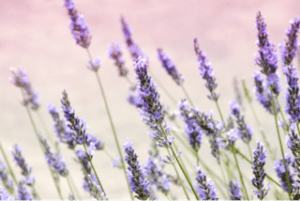UPDATE: I now have a free essential oil guide for you! You can grab it here.
Lavender is an essential oil everyone needs in their home. It’s benefits range from medicinal to the aromatic properties. Since it’s commonly used in sleep lotions, uou have probably encountered the scent at one point or another (although this could be from artificial sources, not the essential oils). Egyptians used lavender for the mummification process and as a perfume. Romans used it for bathing and cooking. Lavender has many uses, some of which may surprise you. Let’s dive into what they are.
 Common Uses of Lavender
Common Uses of Lavender
1. Accelerates Wound Healing
In the 1910’s a French chemist by the name of Maurice-Rene Gattefosse burnt himself in his lab. He noticed he was developing gas gangrene, so covered his burns with lavender essential oil. In the early 1900s, this was the cause of many amputations and deaths. His burn healed quickly and there was little scarring. He later went on to use lavender essential oil to help heal wounds and prevent gangrene in a military hospital during WWI.
2. Possesses Antibacterial Properties
During the Black Death era, it was observed that people who lived in an English village that was the center of lavender trade didn’t become ill or die as often from the Bubonic Plague. One study tested two different types of lavender and found that both contained antibacterial properties & the higher the concentration of monoterpentoids and monterpenes equated to better bacteria fighting abilities.
3. May Decrease Anxiety and Depression
Lavender is known for it’s relaxing effects. Because of these qualities, it can help lessen anxiety and depression. One study found that blending rose and lavender essential oils at 2% (6 drops in 10 mL of a carrier oil) dilution and applying it for 15 minutes, twice a week for 4 weeks. No difference was noted in the amount of anxiety and depression among postpartum women before the study. But by the two and four week marks, there were significant differences. This suggests that these oils played a role in decreasing women’s postpartum depression and anxiety.
4. Reduces Dysmenorrhea Symptoms
In one Turkish study, one group of midwifery and nursing students applied lavender oil to their lower abdomen and performed abdominal massage while the other group did not. The group that performed a lavender abdominal massage had lower pain scores than the placebo group.
5. Helps Relieve Migraine Pain
A study in European Neurology looked at the effects of individuals who inhaled lavender essential while experiencing a migraine. They found that out of the 129, 92 reported an entire or partial decrease in pain compared to 32 out of 68 in the placebo. So the next time you have a headache, mixing 3 drops of peppermint and 4 drops of lavender in a diffuser or personal inhaler could help with your headache or migraine.
 Diluting Essential Oils
Diluting Essential Oils
Lavender essential oil is more a mild oil. When saying this, I mean that it’s not like peppermint or cinnamon where you will feel a ‘hot’ sensation when it hits your skin. That being said, it’s always safest to dilute your oils, especially if you’re using them for long term use. Other things to consider are overall skin sensitivities, if you’re pregnant or breastfeeding, and certain medical conditions or medications.
Lavender can usually be used at a dilution of 2-5%. Always use the smallest dilution rate that you can to achieve your results. If using greater than a week, also use the lowest dilution to decrease your chances of developing a sensitivity to the oil.
As a general rule of thumb, lavender essential oil can be diluted as follows:
6 months – 24 months : Avoid unless urgent
For this age group, it’s easy for oils to build up in your little one’s system. So unless you’re treating something specifically, try use lavender as a herb or hydrosol instead.
2-6 years old: 0.25% or 1 drop per 4 teaspoons of carrier oil
Hydrosols and herbs are still great for this age too!
Older than 6 years old: 1% or 1 drop per 1 teaspoon of carrier oil
Also a good recommendation for pregnant, breastfeeding, the elderly, or those with certain health conditions
Healthy Adult: 2% or 2-3 drops per teaspoon of carrier oil
This is considered a good dilution for every day use
Short Term Usage: 3-5% or 4-7 drops per teaspoon of carrier oil
As I mentioned, these are general guidelines. Do your own research to see what you feel comfortable with. Also, if you speak to a certified aromatherapist and they tell you to go ahead and dilute heavier, then go for it. Just ensure you’re talking to someone who has actually studied essential oils. With essential oils gaining popularity, adverse reactions are on the rise. Using essential oils safely is important so our government doesn’t start ripping them off the shelves and requiring prescriptions for them which will inadvertently increase the prices.
Want to grab my favorite lavender oil? Click the banner below!
Here to learn more about essential oils? Then you may also like learning about lemon essential oil.
Disclaimer: These statements and products have not been evaluated by United States Food and Drug Administration and are not approved to diagnose, treat, cure, or prevent disease. The information given is not intended as a substitute for advice from your physician or other health care professional.

Leave a Reply